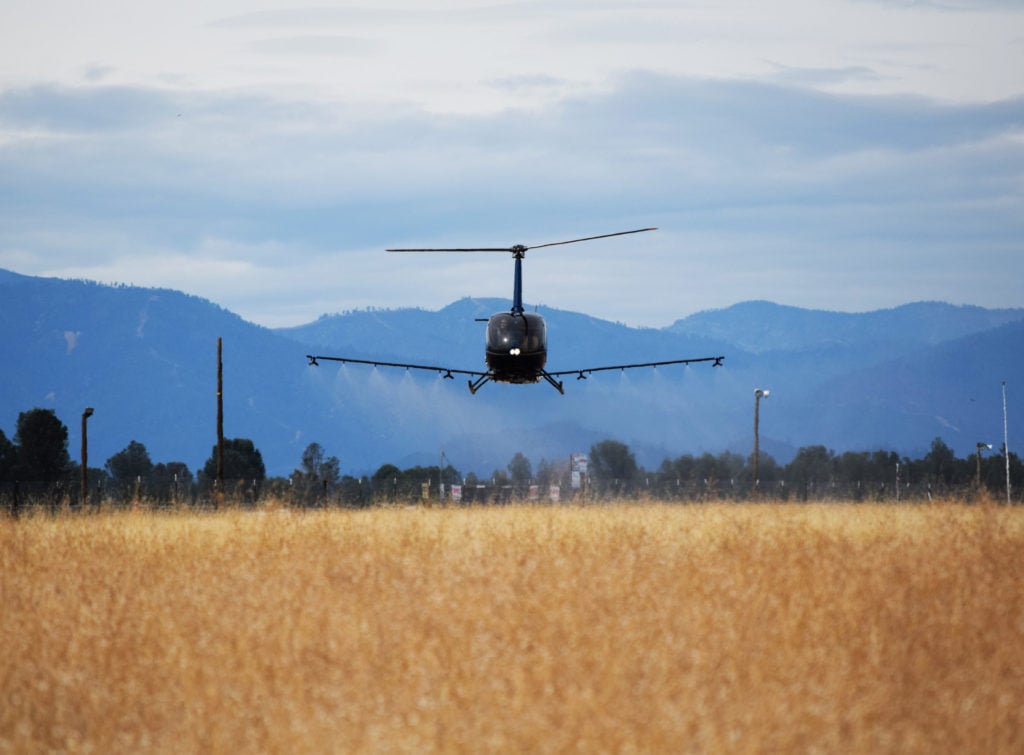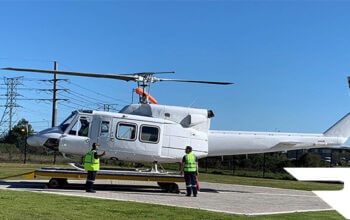
As Canadian field crop producers near the end of a busy growing season, the country’s aerial spraying industry is reporting a seasonal uptick in flight activity for fungicide applications.
The increase is due in part to the prevalence of natural toxins (vomitoxins) produced by fungi growing on crops in southwestern Ontario, said Shara Tardif, executive director of the Canadian Aerial Applicators Association (CAAA).
“As well, there has been an ever-growing increase in tar spot,” Tardif said in an email interview with Vertical, referring to yellowish-green leaf spots that are among the first signs of a diseased plant.
“Which led some growers to request a second application of fungicide, which is uncommon in this region of the country.”
About 15 percent of the agricultural spraying fleet in Canada is made up of helicopters, and demand is higher in the smaller fields of the eastern provinces. Aerial sprayers primarily treat corn, tomatoes and wheat in southwestern Ontario; in the breadbasket region of Manitoba, Saskatchewan and Alberta, they spray a mixture of corn, canola and barley.
The remaining aerial fleet, and the bulk of spraying activity in the central and western provinces, is made up of fixed-wing aircraft that can more efficiently cover large swaths of land.
“There has been an increase in the western provinces in helicopter utilization,” said Tardif. “But [it’s] still primarily fixed-wing … field sizes are drastically larger [in the West].”
At Zimmer Air Services in Blenheim, Ontario, the company reported a “very busy” summer, attributed to a rising awareness of the effects of soil compaction by land-based sprayers and the reported spread of diseases between fields by land vehicles.
“By going aerial, they avoid those issues,” said Chris Bell, sales and customer relations at Zimmer Air, which operates a fleet of 13 helicopters — including Robinson R44s, Airbus AS350s and Bell 206 variants.
The company is headquartered in Blenheim, a small town in the largely-rural municipality of Chatham-Kent, about six miles (10 kilometers) inland from Lake Erie and 62 miles (100) kilometers east of Detroit. It has secondary locations in the Ontario cities of St. Thomas and Thunder Bay, as well as Outlook, Saskatchewan.
“Every hour that we were able to fly, we were flying,” said Chris Bell. “It’s a growing market.”
Agricultural spraying was deemed an essential service in Canada during the height of the Covid-19 pandemic, and operators were not subject to the same lockdowns as other sectors. In many cases, pilots flew alone in the cockpit, negating physical distancing requirements.
“We still need food for livestock and for ourselves,” said Bell. “It’s still something everybody needs on a day-to-day basis, whether we’re in lockdown or not.”
In Canada, most aerial applicators are wrapping up their season and preparing to launch their winter maintenance regimes. The CAAA expects the rest of 2023 to be relatively quiet, and it’s difficult — if not impossible — to provide an outlook for next year since the sector is largely weather-dependent.
“Most of our work is directly related to Mother Nature,” said Shara Tardif. “We are hopefully that with [adequate] precipitation the 2024 season will be strong, but it’s too early to tell at this point.
Farming is in many ways a fickle business, and aerial applicators are in constant competition with large-scale ground spraying operations. Still, Tardif is optimistic about the sector’s future.
“I feel the demand and interest for aerial application in Canada regarding helicopters is in a good place,” she said, offering several caveats related to geography and weather. Farming in Canada is never easy, nor simple.
“Coverage by ground has always been an issue in terms of competition, and always will be,” she said. “Some customers are loyal and are return customers; however a large portion only ask for assistance when needed, and treat aerial application as an ambulatory service.”









